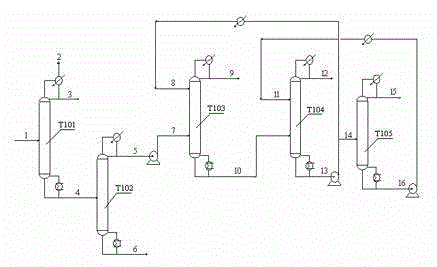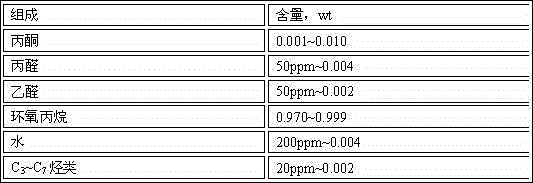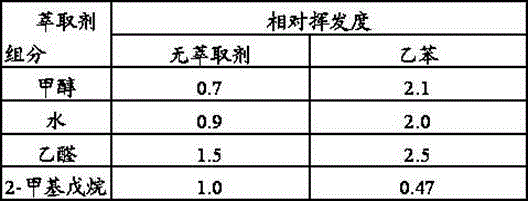Method for refining epoxypropane
A technology of propylene oxide and refining method, applied in the direction of organic chemistry, etc., can solve the problems of poor product quality and high cost of extraction agent, and achieve the effect of reducing circulation accumulation
- Summary
- Abstract
- Description
- Claims
- Application Information
AI Technical Summary
Problems solved by technology
Method used
Image
Examples
Embodiment 1
[0041] use figure 1 Process shown, containing water, acetaldehyde, propionaldehyde, methanol, acetone, C 3 ~C 7 The composition of stream 1 (crude propylene oxide solution) of impurities such as hydrocarbons is shown in Table 4.
[0042] Table 4
[0043] composition Content, wt acetone 0.005 Propionaldehyde 0.002 Acetaldehyde 0.001 Propylene oxide 0.988 water 0.002 C 3 ~C 7 Hydrocarbons 0.001
[0044] Stream 1 is fed from the lower part of T101 tower. Stream 3 (T101 overhead distillate) mainly contains acetaldehyde and a small amount of propylene oxide. To the outside of the system, stream 2 (T101 top non-condensable gas) mainly contains C 3 ~C 4 Hydrocarbons, acetaldehyde, to flare. The theoretical plate number of T101 column is 55, the operating pressure is 250kPa, and the reflux ratio is 200.
[0045] Stream 4 (T101 tower bottom liquid) is fed from the middle and upper part of T102 tower, T102 tower bottom liquid ...
Embodiment 2
[0055] use figure 1 Process shown, containing water, acetaldehyde, propionaldehyde, methanol, acetone, C 3 ~C 7 The composition of stream 1 (crude propylene oxide solution) of impurities such as hydrocarbons is shown in Table 6.
[0056] Table 6
[0057] composition Content, wt acetone 0.006 Propionaldehyde 0.003 Acetaldehyde 0.001 Propylene oxide 0.985 water 0.003 C 3 ~C 7 Hydrocarbons 0.002
[0058] Stream 1 is fed from the lower part of T101 tower. Stream 3 (T101 overhead distillate) mainly contains acetaldehyde and a small amount of propylene oxide. To the outside of the system, stream 2 (T101 top non-condensable gas) mainly contains C 3 ~C 4 Hydrocarbons, acetaldehyde, to flare. The theoretical plate number of T101 column is 65, the operating pressure is 230kPa, and the reflux ratio is 180.
[0059] Stream 4 (T101 tower bottom liquid) is fed from the middle and upper part of T102 tower, T102 tower bottom liquid ...
Embodiment 3
[0069] use figure 1 Process shown, containing water, acetaldehyde, propionaldehyde, methanol, acetone, C 3 ~C 7 The composition of stream 1 (crude propylene oxide solution) of impurities such as hydrocarbons is shown in Table 8.
[0070] Table 8
[0071] composition Content, wt acetone 0.005 Propionaldehyde 0.004 Acetaldehyde 0.002 Propylene oxide 0.984 water 0.003 C 3 ~C 7 Hydrocarbons 0.002
[0072] Stream 1 is fed from the lower part of T101 tower. Stream 3 (T101 overhead distillate) mainly contains acetaldehyde and a small amount of propylene oxide. To the outside of the system, stream 2 (T101 top non-condensable gas) mainly contains C 3 ~C 4 Hydrocarbons, acetaldehyde, to flare. The theoretical plate number of T101 column is 60, the operating pressure is 250kPa, and the reflux ratio is 200.
[0073] Stream 4 (T101 tower bottom liquid) is fed from the middle and upper part of T102 tower, T102 tower bottom liquid (s...
PUM
 Login to View More
Login to View More Abstract
Description
Claims
Application Information
 Login to View More
Login to View More - R&D
- Intellectual Property
- Life Sciences
- Materials
- Tech Scout
- Unparalleled Data Quality
- Higher Quality Content
- 60% Fewer Hallucinations
Browse by: Latest US Patents, China's latest patents, Technical Efficacy Thesaurus, Application Domain, Technology Topic, Popular Technical Reports.
© 2025 PatSnap. All rights reserved.Legal|Privacy policy|Modern Slavery Act Transparency Statement|Sitemap|About US| Contact US: help@patsnap.com



